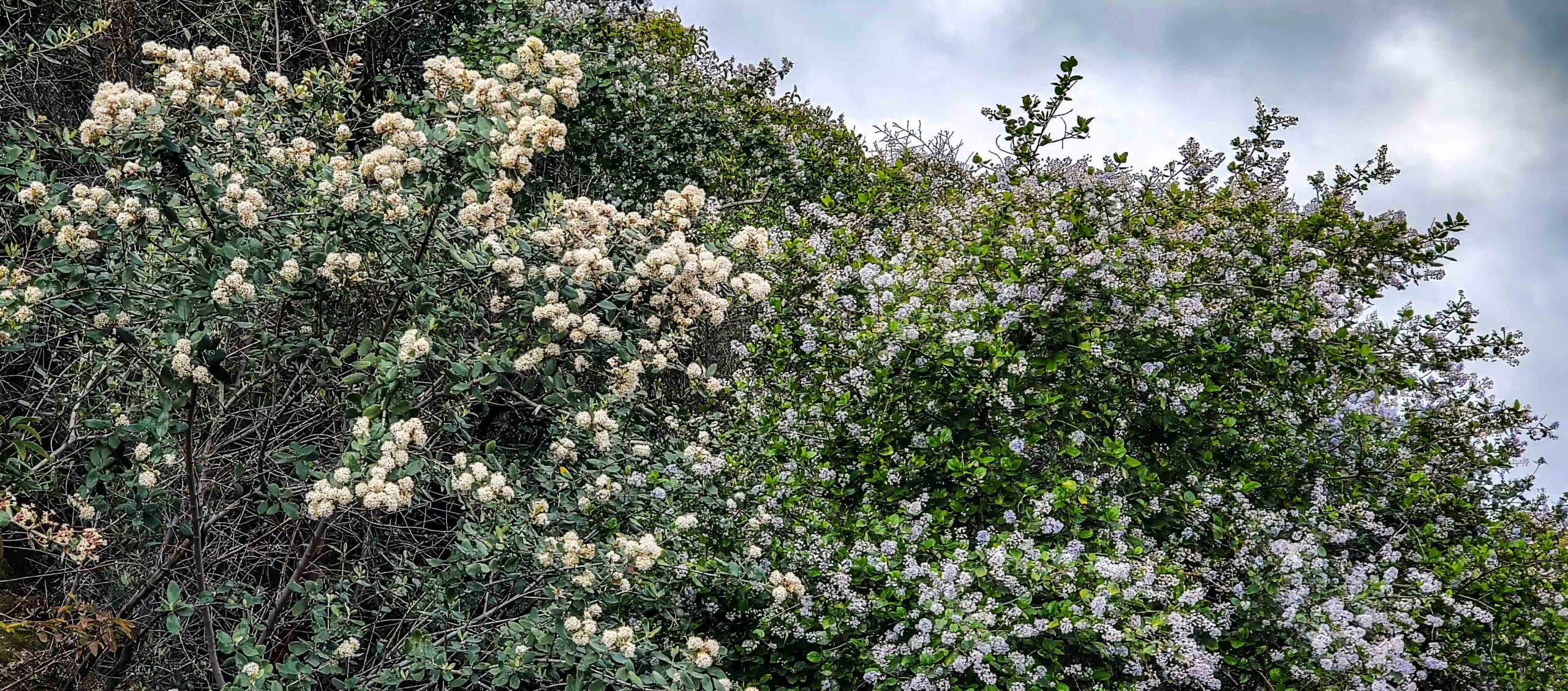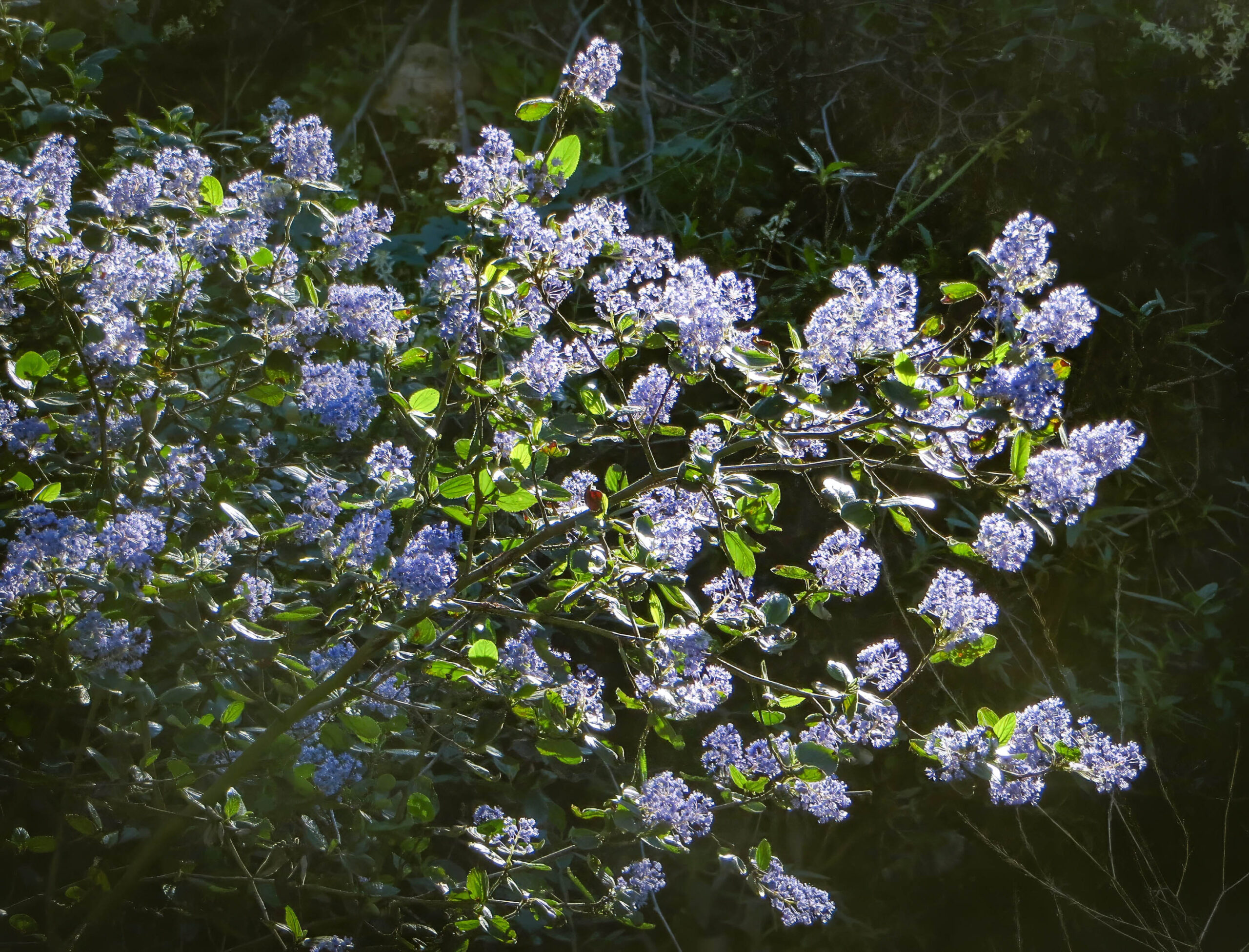Occasional notes on the wildflowers of 91011
Lilacs are one of the world’s most beloved garden flowers, prized for their fragrance. But true lilacs require a cold winter to flourish, and that rules out much of Southern California. Once again, though, the yearning of Angelinos for fragrant clusters of white-to-blue-to-purple blossoms has been met by one of our native plants: the genus Ceanothus. Together, the 50+ species of Ceanothus in our state are often referred to as “California lilacs.” Yet while they too are popular as garden shrubs all over California, their native habitat is a bit surprising, because their natural home is in the midst of chaparral, that rugged terrain typically dominated by dense and woody shrubs, by sage, greasewood, and scrub oaks.
The nearby San Gabriel Mtns. are home to over a dozen Ceanothus species, two of which are common in Cherry Canyon: Hoary-leaf Ceanothus (C. crassifolius), with white or cream-colored flowers; and Hairy-leaf Ceanothus (C. oliganthus), with blue flowers ranging from pale blue to deeper shades of purple.

It’s not unusual to find both Hoary-leaf (left) and Hairy-leaf (right) growing side-by-side,
but it’s rare to find them equally in bloom at the same time!

Hoary-leaf Ceanothus (C. crassifolius) is always the first to bloom at Cherry Canyon, usually sometime in March. These are often large shrubs, and though the blossoms are white, the buds are dark brown and tightly closed. Once they open, the shrub is covered with small clusters of white blossoms — and at a distance, the hillsides look as if they are dotted with giant cotton balls. Closer up, you can see how this flowering shrub earns its name: the leaves are indeed “crass” (in the sense of coarse or rigid) and their undersides are hoary or frosty.

Hairy-leaf Ceanothus (C. oliganthus) will bloom two or three weeks after Hoary-leaf Ceanothus — though among flowers, there are always the proverbial early bloomers and late bloomers! Many prefer its blue blossoms to the Hoary-leaf’s white blossoms, but the blue blossoms are not as eye-catching except up close. In fact, at a distance, hillsides that are dense with the blue blossoms of this Ceanothus will actually look gray. The leaves of Hairy-leaf are also distinctive and attractive: they are softer and a much brighter green, the undersides are not frosted but upholstered with distinguishable hairs, and they have three especially prominent veins that run the almost the full length of the leaf.

The flowers of both species have a very faint fragrance. For a more powerful scent, try venturing higher into the San Gabriels (above 2000′), where you’ll find Chaparral Whitethorn (C. leucodermis), which has sky-blue flowers and, on a warm day, emits an overpoweringly sweet scent of honey.

Where and when to find them. Hoary-leaf and Hairy-leaf Ceanothus are common throughout the lower foothills of the San Gabriels and Verdugo Mtns. The lower section of Liz’s Loop is reliable for both plants, but the western slopes of Cherry Canyon (above and east of Hwy. 2, visible from near the Cerro Negro tower) abound in Hoary-leaf Ceanothus, easily seen from a distance. Their blooming periods vary, but blooming usually begins in March and ends in May.
- For more about Ceanothus, visit Wikipedia.
- For information about growing Ceanothus in your yard, visit Calscape.org.
- For distribution maps, taxonomy, and more photos, visit Calflora.org.
- And go here to read other occasional notes on the wildflowers of 91011.

